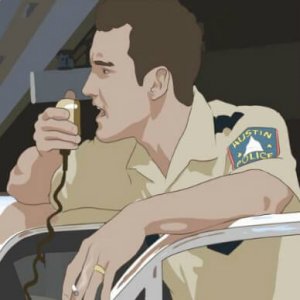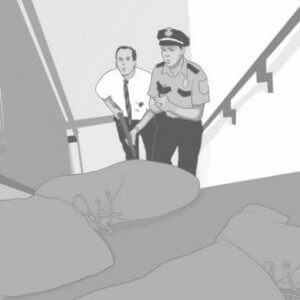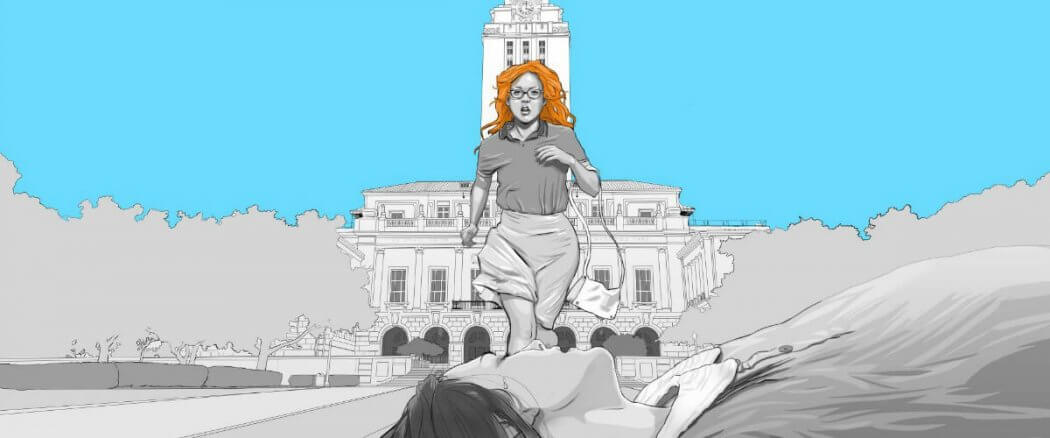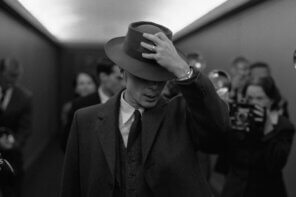Every once in a while a documentary comes along that unexpectedly stops you in your tracks. Tower is one of those. The film tells the story of the worst U.S. mass shooting by a single person in the 20th century, and the very first episode to take place at a school. It occurred on a top-of-the-thermometer, baking-hot, August 1966 day in Austin, Texas — a time when America was more worried about ending the Vietnam War than random acts of public violence. To a United States not yet used to civilian mass killings of strangers with no discernible motivation, the shooting shocked the citizens of Austin, and the country, who were initially certain that the gunfire was a Black Panther uprising or an anti-war demonstration turned homicidal. Instead it was the crazed act of former Marine sharp-shooter Charles Whitman, who first murdered his wife and mother and then went to the University of Texas campus in Austin armed with multiple rifles and over 700 rounds of ammo. He wounded or killed the attendants on the deck and then began to pick off citizens from his 28th floor vantage point that oversaw the entire campus and adjoining city area. Ninety-two minutes later sixteen people were murdered and over three dozen were wounded, many seriously with wounds they would deal with for the rest of their lives. All but the first two of his victims were randomly chosen.
Not About the Shooter
But the documentary is not about the shooter, whose name is spoken only three times in the film. It is about those who were injured and killed, those who aided them and those who, after 96 minutes, stopped the carnage. And this documentary is told in a way you have probably never seen before. The film was conceived by Texan and fledgling filmmaker Keith Mailand, who was too young to have lived through that horror. A documentarian whose only previous major directorial credit was 2010’s The Eyes of Me, Mailand remembers being told of the event by a middle school teacher who was attending the university at the time of the shooting. While working on The Eyes of Me, Keith read an article about the shooting in the magazine “Texas Today” and realized this story needed to be put on film. Mailand crafts an amazing film that at its root is a passionate oral history set to animation of what happened that day from, primarily, the perspectives of eight of the people there on that fateful day.
 In an interview director Mailand said he made a movie that looks at the tower shootings “from the ground up, instead of the top down.” Some critics have panned the film as being, with hardly any mention of Charles Whitman, an incomplete story which causes the documentary to be “a failure” — but I do not. The story of Charles Whitman is another documentary yet to be made, and maybe someone will make it one day. But Tower is a testament to the experiences and courage of those who were on the ground.
In an interview director Mailand said he made a movie that looks at the tower shootings “from the ground up, instead of the top down.” Some critics have panned the film as being, with hardly any mention of Charles Whitman, an incomplete story which causes the documentary to be “a failure” — but I do not. The story of Charles Whitman is another documentary yet to be made, and maybe someone will make it one day. But Tower is a testament to the experiences and courage of those who were on the ground.
Such a documentary may sound dry but the histories are performed by actors reading the interview memories of those who offered up their testimony. Their images as they were that August 1st day are beautifully rotoscoped, which is a technique where animators trace over motion picture footage, frame by frame (as in Richard Linklater’s Waking Life and Brett Morgen’s Chicago 10) with various backdrops of the Austin campus and streets as well as animated depictions of the principals’ actions that day. It is impossible for me to tell you how beautiful the fluid animation is, how brilliant are the colors, and how seamlessly the interplay of archival footage flows forward and backward into the animation. And the stories the characters tell are anything but boring… they are, indeed, riveting. For a small, but inadequate taste, see the film’s trailer.
The Involuntary ‘Cast’
The first and central character to which we are introduced is Claire Wilson. We first see her in rotoscoped animation and she is incredibly beautiful. You immediately feel empathy for this happy, in love, eight month pregnant coed who was the first person not in the tower to be critically shot on campus. She is a constant throughout the entire film and in the last third of Tower you actually see her true face as she is now. After hearing her thoughts and emotions throughout the documentary, as she lies on the sizzling-hot cement of the plaza under the tower while slipping into shock from blood loss, one is anxious to finally “meet” the real Claire. And as you will see the present day Claire is even more amazing that the Claire of 1966.
In addition, we meet each of the two policemen who eventually take the sniper down; an older bookstore clerk who volunteers to accompany the policemen even though he has no police training; a Latino paper boy who is shot while delivering papers; a senior from a local high school who dares to do what no one else will; the radio announcer whose eyewitness, live account was eventually fed to the entire shocked nation and world; and a student who visualized the events while admitting she was not brave enough to go out and help. As with Claire, we see those seven characters in their animated representation as they were that August 1st day, and then at the end of the film as they are now. All have been indelibly changed by their experiences… most for the better but some not. Some minor witnesses are no longer living and are represented by their last recorded interviews. To see each one’s face after listening to their words is absolutely engrossing.
Who Are Our Heroes?
Many films deal with the presentation of heroes — either real-life or imaginary. In this country we inaccurately label entire classes of people “heroes” — soldiers, policemen, firemen, mothers, and physicians (yikes!). In each of those categories there are some true heroes… as there are in every class of people. But many who wear that label solely because of their job description are not truly heroes… they are doing what is expected, and sometimes less. In this film we learn of a few people, particularly two, who went far beyond what anyone would expect as reasonable and can truly be called heroes.
 The one who will stick with me forever, I think, is a 17-year-old high school senior, John “Artly” Fox, who was that summer taking college level English on the university campus and after class visited another high school friend, James Love, who had already moved onto campus. Hearing distant gunfire and reports on the radio of gun shots on campus (described as being from an air rifle) both boys realized that the location was close and, in the unwise way of teens, they decided to run over to see what was happening. They were astounded to suddenly find themselves in the thick of a truly life-and-death scene.
The one who will stick with me forever, I think, is a 17-year-old high school senior, John “Artly” Fox, who was that summer taking college level English on the university campus and after class visited another high school friend, James Love, who had already moved onto campus. Hearing distant gunfire and reports on the radio of gun shots on campus (described as being from an air rifle) both boys realized that the location was close and, in the unwise way of teens, they decided to run over to see what was happening. They were astounded to suddenly find themselves in the thick of a truly life-and-death scene.
Artly arrived at the plaza in front of the tower to see Claire lying on the pavement totally exposed to the shooter as would be anyone that attempted to aid her. With her life ebbing away he knew, yes… he was convicted, that he had to do something. It brings tears to my eyes when he tells us over 50 years later “There’s a cold spot I can feel in my back right now… Its about the size of a grape. Its halfway up my spine — halfway between my shoulder blades. And it’s the place I expected the bullet to come in.” The actual video of he and James swooping Clarie’s arms and legs up and frantically carrying her to shelter is breathtaking… And he never saw himself as a hero, nor did the media proclaim him one. Until this film he was largely unrecognized even though he continued to live his life in Austin.
Artly’s bravery is only slightly less astounding to me than that of college student Rita Starpattern. For whatever reason Rita had earlier run out to Claire and then, realizing she with her bright red hair was herself a target, laid down on the oven-like surface beside Claire — fully exposed to the gunman. For the next half hour Rita held Claire’s hand and quietly spoke to her (“I’m here with you now.”) offering support and comfort. Again, she was not proclaimed a hero even though Claire credits her (along with Artly and James) with saving her life. Sadly, we have no first hand report from Rita for reasons told in the film. Claire only saw her once after the incident. But the courage of these two people is stunning, not that they ever saw their actions in that light. In fact, Artly says that even today he feels “guilty” he did not take action more quickly.
 We hear from the others… the unsuspecting Latino newspaper boy shot off his bike while delivering papers; police officer Martinez who had the day off and, after hearing reports of the shooting on the radio, called the chaotic police headquarters to ask if they wanted him to come in. We hear the radio newsman who left his studio and ended up broadcasting, despite being under fire, his eye witness “live” reports that were picked up around the world; the college student in the shelter of a classroom who admits she was too afraid to go out and help anyone, and several others. All are fascinating. All still yet carrying the emotional trauma and grief, if not the physical wounds, of this event. The narratives all seem to be remarkably honest with the female student admitting after she saw someone near her hit, “That was the moment that separated the brave people from the scared people. I knew there was no way that I was going to go out there and help him. I didn’t want to get shot. That was a defining moment because I realized I was a coward.”
We hear from the others… the unsuspecting Latino newspaper boy shot off his bike while delivering papers; police officer Martinez who had the day off and, after hearing reports of the shooting on the radio, called the chaotic police headquarters to ask if they wanted him to come in. We hear the radio newsman who left his studio and ended up broadcasting, despite being under fire, his eye witness “live” reports that were picked up around the world; the college student in the shelter of a classroom who admits she was too afraid to go out and help anyone, and several others. All are fascinating. All still yet carrying the emotional trauma and grief, if not the physical wounds, of this event. The narratives all seem to be remarkably honest with the female student admitting after she saw someone near her hit, “That was the moment that separated the brave people from the scared people. I knew there was no way that I was going to go out there and help him. I didn’t want to get shot. That was a defining moment because I realized I was a coward.”
A Feeling That One Is There
The film is exceptionally well made. It starts with the circle countdown of old newsreels with faded, speckled film footage along with pops, snaps and hissing on the sound track. But soon the video transitions into the beautiful animation and rotoscopic images. The actors who read the memories of those who were there are riveting in their presentation. With the film lasting more or less the same ninety-two minutes the shooter continued to fire from the observation deck, rifle shots repeatedly punctuate the soundtrack — along with the sounds of pigeons and other birds taking flight with each shot. Soon you began to hear the fire of townspeople who, in true Texan fashion, came to the Tower trying to shoot the gunman (but almost all their rifles were unable to reach the observation deck).
 The film has a “you are there” quality. One can feel and almost taste the fear, the indecision and the questioning of the choices each person makes. And the shifting of the backdrops from old photos to period newsreels with rotoscoped pictures laid over them is riveting. In addition the rotoscoped characters are sometimes isolated against solid colored backgrounds or, at times, just solid white or black. Sometimes all the frame is in color, sometimes just a few objects are brilliantly painted in and then again the film may revert to stark black and white, or grays. The visual artistry is constantly fascinating.
The film has a “you are there” quality. One can feel and almost taste the fear, the indecision and the questioning of the choices each person makes. And the shifting of the backdrops from old photos to period newsreels with rotoscoped pictures laid over them is riveting. In addition the rotoscoped characters are sometimes isolated against solid colored backgrounds or, at times, just solid white or black. Sometimes all the frame is in color, sometimes just a few objects are brilliantly painted in and then again the film may revert to stark black and white, or grays. The visual artistry is constantly fascinating.
The musical track is, of course, occasionally filled with tunes from my teens (I was 19 years old at the time). These pop hits brought back wonderful nostalgia and then, amid the horror, bitter irony. About halfway through the film, surprisingly, a piano begins to play Debussy’s “Claire de Lune.” That quiet and soothing theme recurs from that point forward… even during the tense moments the officers are closing in on the shooter and through the aftermath of the shootings. It really makes no sense that “Claire de Lune” would be appropriate for this movie but it works so well.
Repercussions
Interestingly, the University of Texas chose to deal with this event by quickly trying to forget it. They suspended school for only one day and then, with the cement still showing blood stains, resumed classes without any memorial service for those killed or injured, nor any celebration of the actions of those who displayed such fearlessness. For decades the only record of the event on campus was a small, out-of-the-way 8 by 14 inch plaque about a half block from the plaza briefly stating the bare-bones facts with no names of those whose lives were forever altered. There was, likewise, no mention of this event in any campus materials while human guides at the tower were instructed to not speak of the event nor answer questions about the shooting. It was only on the 50th anniversary in 2016 that a memorial was finally erected listing the names of those killed and injured… all victims in their own way. Ironically, on that same day a law passed by the Texas legislature went into effect to allow open carry on all Texas campuses.
All the people interviewed are plagued with memories and nightmares of the events of that day in 1966. The film made me realize that, whether people did the noble thing or not, their life was forever shaped by the 92 minutes of this grim incident. Some cracked under the strain, and others used it to propel themselves to greater love and greater compassion. And with each new mass shooting (we have suffered through so, so many episodes since then), many more people live with the guilt and trauma — the lasting consequences.
The Balm of Forgiveness
As a Christ follower I learn, once again, of the grace that I as a Christian must offer to others because of the grace God freely offered me. Claire Wilson is asked, late in the film, how she feels about the man who shot her for no reason, killed her unborn child, kept her from ever having another biological child and murdered her boyfriend… all committed for no reason whatsoever by a complete stranger. She answers without hesitation that she holds no anger towards Whitman and blames early events in his life for causing him to perform this monstrous act. She sees the perpetrator as “a very confused, very damaged young man who died at 25 years old. How can I hate someone like that?” When directly asked if she forgives him she acts almost shocked saying “I forgive him, yes. How can I not forgive him? I’ve been forgiven so much.”
Could I follow in her footsteps… as forgiving and compassionate? Could I be as brave as Artly and his friend, or Rita… or Officer Martinez? God give me the strength.
Tower is available on Netflix as well as many streaming services and on DVD.





